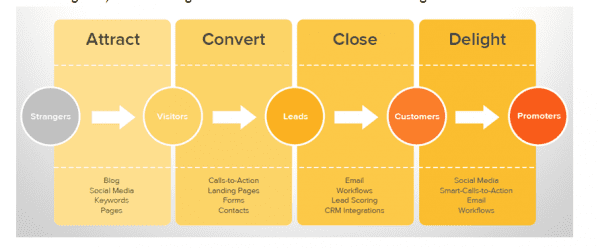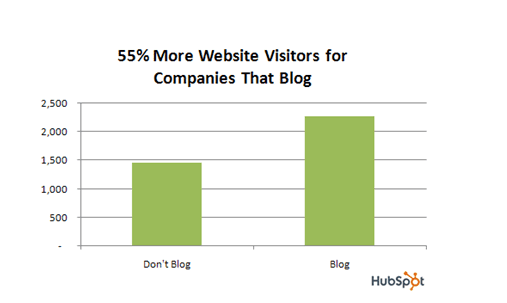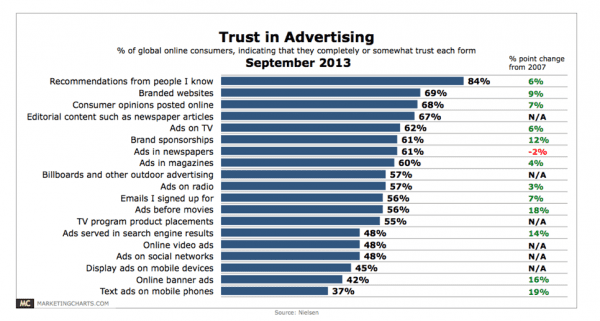4 Steps to Inbound Marketing Success
One of the biggest challenges business owners as well as marketers will face in 2014 is how they can use different online media together to achieve inbound marketing success. Many think of (social media, email, search…etc) in silos, and that’s the reason why many inbound marketing strategies may fail.
In order for you to be able to design a less siloed, more effective inbound marketing strategy, I have found you need 3 elements:
-
1. A defined customer journey
This begins when a complete stranger finds your brand online. They go through a conversion path that is designed to turn them into customers and then turn those customers into evangelists who will promote your brand for you. You might get lucky turning very few of those strangers into customers from the first interaction if your product and copy resonates with them really well, but then you’ll be missing on the vast majority of the remaining prospects that could really benefit from your products or services.
-
2. Applying the right media to support each step
Once you figure out the steps that lead to a purchase, you need to apply the best channels to support each step of the process. This ensures that you only use the right mediums for the right steps.
-
3. How these media should work together
As I mentioned before, all the online mediums that your business should be benefiting from should work together in order for the strategy to work. Isolating them will only waste your valuable resources.
That being said, here is a diagram that shows the inbound marketing funnel according to the originators of the inbound marketing concept:

Source: HubSpot.com
As you can see in the diagram above, there are 4 main phases to turning strangers into loyal customers. Following this funnel will ensure that you don’t lose the other prospects who might be interested in what you’re offering, but they’re not ready to purchase yet.
Let’s do the maths!
- Imagine that you have an advertising budget of $5,000.
- Let’s say that you’re not a patient person and you want to jump through the funnel above by directing all of that traffic to a sales page.
- Assuming you’re paying 25 cents per click, you’re going to get 20,000 visitors to your sales page. Let’s say that your sales page converts at 1%.
- That means that only 200 people of those 20,000 visitors will convert into paying customers.
What about the other 19,800?
They’ll probably leave and never come back again because your copy didn’t convince them, they don’t know you, they don’t trust you…etc.
Would you throw 19,800 visitors out the window while you can get more of them to convert into paying customers?
That’s what the above inbound marketing funnel is for. It’s about maximizing your conversions. If you ask every marketer on earth, they’ll always tell you that people buy from businesses they know, like and trust which are the outcomes the funnel above achieves for your business!
4 steps to Inbound Marketing
So, now let’s jump into each step in detail:
This step is all about turning complete strangers who probably never heard about your business before into visitors who see your content multiple times.
This is the awareness phase where you get your brand in front of your prospects. You won’t obviously ask for the sale directly here, you’re just educating them about your brand, your products or services.
In order to achieve this step and get to the next one, there are several effective mediums that you can use. However, I’m going to mention 2 of the most effective:
- Blog: having a blog that you update consistently is proven to bring you more traffic. According to a HubSpot study, companies that blog get 55% website visitors than companies that don’t!

Blogging if done correctly will help your business attract strangers and turn them into visitors who check your content regularly.
- Social media: Many businesses use social media as a direct selling tool and that’s exactly why they get disappointed when they don’t get results from this medium. They then start blaming the medium instead of analyzing why exactly this medium doesn’t work in terms of direct selling.
Do you remember the 2nd condition to inbound marketing success?
It’s applying the right media to the right situation.
Each medium is good at something, and social media happens to be very good at getting awareness for your brand as well as retaining existing customers and turning them into promoters as you can see in the previous diagram.
Now that you have visitors who showed interest in your brand, the next step will be getting them into an email list because this medium happens to be very good at converting your prospects into paying customers.
In order for you to convert those visitors into leads, you need high converting landing pages.
When I say landing pages, I mean any mechanism that you use to collect emails. Some people call them squeeze pages, others call them opt in pages, and they all basically have the same job.
Getting your prospect permission to email them! For this you’ll need a lead magnet or as some people prefer to call it an ethical bribe + a landing page to show the benefit of that lead magnet.
A lead magnet could be any free offer from ebooks and reports to video series and webinars. Just make sure it’s perceived as high value by your prospects so you get better conversion rates.
Also, for more information about landing pages, check Neil Patel’s post entitled 'The Anatomy of a High Converting Landing Page'
This phase is all about turning those leads into paying customers and you do that by overcoming your prospects objections.
Let’s say that in your buyer persona, your prospects objections were: I don’t think your product is right for me, I don’t have time, I don’t have budget, Why would I trust you…etc.
By answering all of those questions in an automated email autoresponder series, your prospects will be more likely to buy from you since those objections are the only thing that was holding them from buying.
The great thing about email autoresponders is that they save you tons of time and help you automate the process of overcoming your prospects objections. Each time a person becomes a lead, they’ll go into the same autoresponder sequence. So you basically create the content once, and it’ll continue to serve you for months or even years to come!
Many businesses stop when they get the customer. I’m not saying this is wrong or anything, but I believe we’re here to maximize conversions, right?
Why stop at that point, when we can get those customers to become promoters for our business.
The best promoters are customers because they used your products or services and when they recommend them to anyone inside their circles, they’ll respond.
Some of your customers might have a friend or a family member that can benefit from your product. Others might have a huge online audience that can also benefit from your product.
A study from Nielsen reveals that the number 1 thing people trust when it comes to purchasing is recommendations from other people they know.

Some brands go and waste money on advertising while they already have a loyal customers’ base that can help them promote their brand for them.
Email and social media are both great mediums to delight your customers. You can use them to deliver exceptional customer service, over deliver on what you promised or get personal with the most loyal customers. Some businesses go even further and send personal hand written thank you notes to some of their customers. I’ve even seen some cases where CEOs write thank you notes and send them to some customers! This is delighting your customers at its best!
Now that you know my ideas on the 4 steps of inbound marketing success, I would love to hear your thoughts on this. Leave a comment bellow!

Thanks to Houssem Daoud for sharing his thoughts and opinions in this blog post. Houssem is a Social Media Marketing Consultant helping small business owners make more profit using digital channels. He’s also the founder of
High Quality Social Media, a blog dedicated for small business social media marketing advice. Check out his
free ebook. You can connect with him on
LinkedIn or
Twitter






 Thanks to Houssem Daoud for sharing his thoughts and opinions in this blog post. Houssem is a Social Media Marketing Consultant helping small business owners make more profit using digital channels. He’s also the founder of
Thanks to Houssem Daoud for sharing his thoughts and opinions in this blog post. Houssem is a Social Media Marketing Consultant helping small business owners make more profit using digital channels. He’s also the founder of



